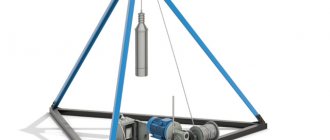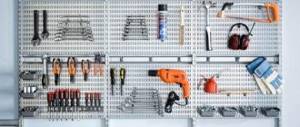The sight of falling streams of water is mesmerizing, the murmur is soothing.
To create an artificial waterfall in a landscape or indoor design, you will need a fountain pump. In order for the water cascade to delight with beauty, an accurate hydraulic engineering calculation of water circulation is required. A fountain is a decorative structure, stylized to look natural. Jets of water emphasize beauty, bring coolness, and play with skillful lighting in the dark. On this topic:
How to use a manual root remover - we make it easier...
May 12, 2019
How to install a fountain with your own hands at your summer cottage
Jan 2, 2019
Let's create a decorative indoor fountain with our own hands using...
Jan 1, 2019
A dent removal tool from China is the dream of many...
Oct 4, 2018
BACK FORWARD 1 of 27
Heron's Fountain: how it works
If we use clever terms, the operation of the Heron Fountain is based on the principle of hydropneumatics - the work of pushing water upward in a stream is done by air and the liquid itself. Naturally, this cannot be done without gravity, thanks to which the necessary pressure is created in the fountain system. This fountain consists of at least three containers.
Fountain of Heron: principle of operation photo
As you understand, such a fountain will work until the liquid in the upper container is used up - after which a recharge is required, due to which this system has nothing in common with a perpetual motion machine or an endless source of energy. Recharging Heron's fountain is quite simple - a full flask (the one that was bottom) is installed instead of an empty container installed on top, which, in turn, is placed instead of a full container. After recharging, the fountain will need to be started - you will need to add some water to the upper bowl.
As you can see, everything is quite simple, and even the principle of making Heron’s fountain with your own hands is no exception. In the elementary version, it is assembled from plastic bottles and transparent tubes - naturally, you will need a bowl, a mounting structure and various little things, which we will deal with as we study the question of how to make a Heron fountain with your own hands?
Variety of fountains
All fountains are divided according to their design into several types:
- The ejection of water upward or at an acute angle to the surface of the mirror is called a geyser. Depending on the performance and pressure of the fountain pump, the water jets can rise several meters, forming a noisy cascading stream. A small room humidifier, raising the fountain a few centimeters above a bowl installed on the bedside table, also belongs to geysers.
- If the water is raised low above the pool and drained through a nozzle, a beautiful transparent dome is created, resembling a cap. Artificial lighting creates the shimmer of a fluid film. Here, accurate calculation of the flow and pressure of the fountain pump plays a major role.
- Cascade - the sight of calmly flowing water along the ledges and crevices of an artificial rocky slope brings coolness and peace. Water, accumulating in small lakes, overflows the edge and continues to move down. Jets of water wash away tension and negativity. In this composition, the fountain pump should operate silently.
- Compositions that connect several points are called hybrid.
Outdoor fountains require maintenance of the water surface, protection from the sun, shutdown and conservation. Indoor structures are easier to make and maintain.
How to make Heron's fountain: assembly features
So, the principle of operation of the Heron fountain is clear; now it remains to understand the intricacies and options for its assembly. There are several different designs.
Fountain of Heron photo
In principle, this is the entire system of the Heron Fountain. The only thing that needs to be added here is to clarify a few details. Firstly, the entire system must have exceptional tightness - there should be only a few open places (drain from the bowl and fountain nozzle). Well, and secondly, the height of the jet of this fountain directly depends on the distance between the upper and lower containers - you will have to adjust this whole thing yourself at your discretion.
Criteria for selecting pumps for fountains
The supply system consists of a pump, a regulator on the discharge line and a nozzle, which gives the shape and pattern to the water cloud. There is a large selection of fountain pumps. It is important to decide whether a submersible or surface apparatus will drive water through the system.
A surface pump is cheaper, but it will have to be installed on the shore of a water bowl. To prevent the windings from accidentally getting wet, for safety reasons, it needs to be stylized, creating a shelter from rain or splashes. This type of equipment is noisy; before starting, it is necessary to fill the suction system with water. It is better if the suction hose has a filter mesh and a check valve is installed on the nozzle. Air in the system is an obstacle to the water supply.
On this topic:
Electronic caliper from China for super-precise…
Jun 14, 2018
In the country kitchen, a tool for cutting vegetables from China
Jun 5, 2018
BACK FORWARD 1 of 50
A submersible pump for a fountain is installed in the water column. The engine and working mechanism are located in a sealed housing. The supply hose is hermetically pressed and filled with epoxy glue. A submersible pump consumes less electricity while doing the same work. But it is not able to work constantly; the engine overheats. The device will need to be dismantled for maintenance.
For a submersible pump, it is necessary to create an elevation at the bottom. Otherwise, it will quickly clog, drawing in bottom sediments.
The fountain pump is selected based on the calculation of the technical values of productivity and pressure presented in the table:
The height, performance and power of the equipment are indicated in the passport of any pump. Low-capacity pumps are suitable for creating home fountains. It is rational if the pump is equipped with:
- a transition pipe that increases the outlet pressure;
- a tee with a valve that allows you to distribute the water flow to two points;
- The head with LEDs, which is used in the pump for the illuminated fountain, is installed on a special threaded extension.
Pumps that are considered fountain pumps include Pondtech AP series and Messener ECO-X2.
On this topic:
How does a sprinkler pump station work?
Installation of a pumping station on a well with drainage for the winter
How to choose a pumping station for your home
AQUAROBOT pumping stations - main characteristics
BACK FORWARD 1 of 26
Decorative lighting gives a fabulous play of light in the stream and surprises with the play of shadows in the pool. To create the lighting effect, halogen and LED lamps and fiber optics are used. Overwater lighting is less dangerous; it is mounted using a 12/24 Volt network through a step-down transformer.
To ensure safety from electric shock, it is necessary to install an RCD - an automatic shutdown system - into the lighting circuit.
The Sprut 1143 fountain pump is most often used in country landscape design.
Submersible pump Sprut 1143 is the smallest of the series. It works silently, is compact, and has 3 nozzles for different types of fountains. Pumps of the FSP, FST, FSS series from the Ukrainian manufacturer are intended for fountains and swimming pools.
Technical data and dimensions of the pump:
- productivity 1 m3/hour;
- head 1.6 m;
- power 22 W;
- pump height with nozzle 27 cm;
- body dimensions 10*8.5*8 cm.
The decorative fountain pump has suction cups at the bottom and is installed so that the suction hole is under the fill.
The more expensive the pump, the higher the performance, the set of additional functions, and the more famous the manufacturer.
You can make a fountain pump with your own hands. There are many options. Let's analyze the simplest one, which will raise the jet by 50 cm. To do this, we use an electric motor from a room fan. Instead of an impeller, you will need to install a wheel, connecting it to the engine. A housing with an inlet and outlet opening is created for the pump, and the entire structure is hermetically sealed.
The baby pumps up to 50 liters of water per hour. The main thing is to make the connection points reliable and well insulate the current-carrying wires. Nozzles can be created from plastic bottles and lighting can be arranged. The scope for imagination is unlimited.
You can install a fountain pump with your own hands by using a drainage apparatus, laying a system of supply pipes, and securing the nozzle. It is enough to fix the device on the bottom and equip it with a pressure-regulating valve and a nozzle. It will be necessary to periodically stop the fountain to cool the pump and replace the intake filter.
It is better to lay the power cable for all types of pumps in a protective casing, deep into the ground.
How to make Heron's fountain: what can be improved
They say that there is no limit to perfection, and almost any thing can be modernized ad infinitum - this is not entirely true, but nevertheless, the possibility of improving any product is almost always available. The Fountain of Heron is no exception in this regard - there are many things that can be modernized in it.
How the Heron Fountain works photo
In general, despite the fact that in general Heron’s fountain is a very well-thought-out product, there is still room for its improvement and, apparently, there is no limit to this place. To conclude the topic, it remains to add that according to the principle described above, it is possible to produce quite a lot of different systems, ranging from small experimental models of fountains to huge working models. With the latter, however, the problem of recharging arises, which is very, very difficult to solve without a pump or other ingenious modern devices.








